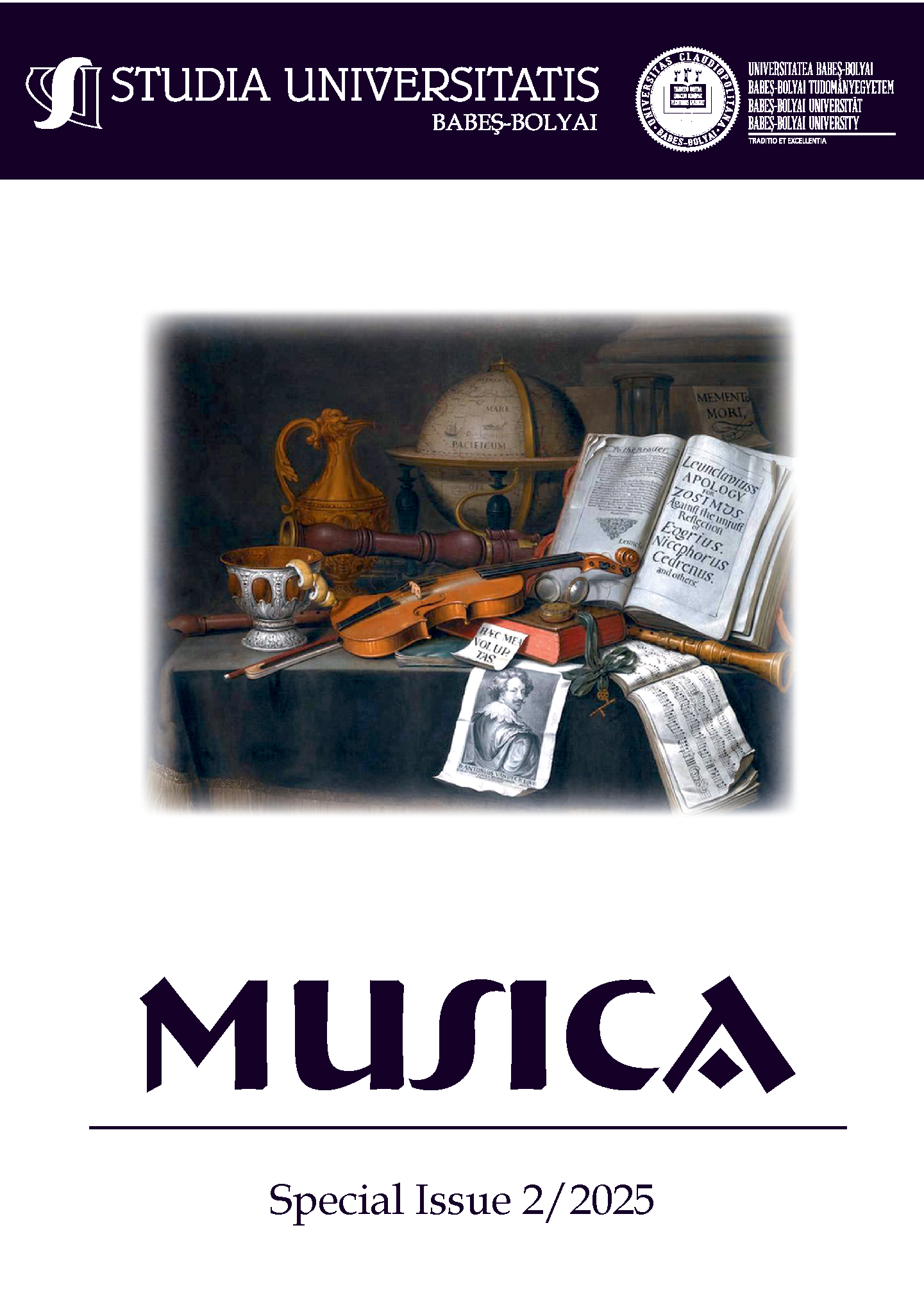UKRAINIAN FOLK INFLUENCES IN CONTEMPORARY CLASSICAL MUSIC: TRENDS AND PROSPECTS
DOI:
https://doi.org/10.24193/subbmusica.2025.spiss2.03Keywords:
postmodernism, folk revival, Ukrainian music, contemporary classical musicAbstract
The world’s folk art is one of the most significant topics in contemporary cultural practice, requiring careful analysis, as it is directly related to the processes of globalization, market transformations, and commerce. Art inevitably engages with themes of identity and self-determination, which become particularly pressing in nations confronting external challenges, as seen in Ukraine during the 2020s. This also applies to musical folklore, which remains an important source of inspiration for composers of academic music today. This article summarizes the role and significance of Ukrainian folk music in the work of 21st century composers. This study aims to examine the incorporation of folk music elements into modern symphonic, chamber, instrumental, and electronic compositions. The analysis focuses on works created between 2000 and 2024. This article analyzes the works of Ukrainian composers who work in a contemporary academic style and use elements of Ukrainian folk songs in their compositions. Folk motifs are integrated into various musical contexts, ranging from experimental electronic music to atonal and aleatoric orchestral textures, jazz harmonies, and dramatic moments in symphonic compositions. Globalization has posed new challenges to the world’s culture in terms of preserving folk art in modern conditions. However, Ukrainian folk art demonstrates considerable resilience and adaptability in the contemporary artistic environment.
References
1. Alonso-Vazquez, Marisol, and Christina Ballico. “Eco-friendly practices and pro-environmental behaviours: the Australian folk and world music festival perspective”, Arts and the Market, vol. 11, no. 2, 2021, pp. 76–91. https://doi.org/10.1108/aam-10-2020-0046
2. Berezhnyk, Sviatoslav. “Atlas Weekend - the largest music festival in Ukraine”, Almanac “Culture and Contemporaneity”, vol. 1, 2019, pp. 222–227. https://doi.org/10.32461/2226-0285.1.2019.180832
3. Bondarenko, Andriy. “Ukrainian electronic music in globalisation and national revival”, Scientific Journal of Polonia University, vol. 43, no. 6, 2021, pp. 9-15. https://doi.org/10.23856/4301
4. Broiako, Nadia. “E. Stankovych’s “Symnoi drimbi zvyki” in the aspect of embodiment of the neofolkloristic tendencies”, Music Art and Culture, vol. 1, no. 30, 2020, pp. 19-24. https://doi.org/10.31723/2524-0447-2020-30-1-3
5. Chabanenko, Nataliia. “Neofolklorism as a stylistic direction in the composer’s creativity of the 20th century”, Culture and Modernity, vol. 2, 2019, pp. 137-141. http://doi.org/10.32461/2226-0285.2.2019.190624
6. Gilstrap, Curt, Andi Teggart, Kyle Cabodi, Julian Hills and Shona Price. “Social music festival brandscapes: A lexical analysis of music festival social conversations”, Journal of Destination Marketing & Management, vol. 20, 2021, 100567. https://doi.org/10.1016/j.jdmm.2021.100567
7. Gintere, Ieva. “Signal and video processing: Developing the noise music trend in digital edugaming”, International Journal of Circuits, Systems, and Signal Processing, vol. 14, 2020, pp. 1176–1180. https://doi.org/10.46300/9106.2020.14.145
8. Izu, Benjamin Obeghare, and Alethea de Villiers. “The functional role of traditional music and dance in Xhosa traditional healers’ ceremonial rites”, E-Journal of Humanities, Arts and Social Sciences, vol. 3, no. 13, 2022, pp. 716-729. https://doi.org/10.38159/ehass.20223136
9. Kamuriwo, Simbarashe T. Transformations in Zimbabwean Traditional Music of North America. Doctoral Thesis, Wesleyan University, 2018. https://doi.org/10.14418/wes01.2.188
10. Kovačič, Matěj, and Urša Šivic. “Migracije nacionalizacije glasbe: Od ljudske k narodnozabavni”, Two Homelands, vol. 58, 2023. https://doi.org/10.3986/dd.2023.2.06
11. Kratochvíl, Matěj. “‹Our song!› Nationalism in folk music research and revival in socialist Czechoslovakia”, Studia Musicologica Academiae Scientiarum Hungaricae, vol. 56, no. 4, 2015, pp. 397-405. https://doi.org/10.1556/6.2015.56.4.7
12. Kyiv Music Fest Program, 2020. “https://composersukraine.org/fileadmin/files/KMF_brochure_Program.pdf
13. Lei, Lei. “The latest technological developments in Chinese music education: Motifs of national musical culture and folklore in modern electronic music”, Education and Information Technologies, vol. 29, 2024, pp. 10595-10610. https://doi.org/10.1007/s10639-023-12227-0
14. Marchenko, Valerii. “Accordion and its role in the development of music arts of Ukraine”, Humanities Science Current Issues, vol. 2, no. 39, 2021, pp. 42–47. https://doi.org/10.24919/2308-4863/39-2-7
15. Marchun, Oksana. “Folk revival as a means of expressing identity and promoting folk motives”, Modern Engineering and Innovative Technologies, vol. 4, no. (32-04), 2024, pp. 92-99. https://doi.org/10.30890/2567-5273.2024-32-00-094
16. Markova, Olena. “The concept of national in music I. Lukashenko in conditions of development of modern performance musicology”, Educational Dimension, vol. 18, no. 1, 2007, pp. 258-267. https://doi.org/10.31812/educdim.5937
17. Mauwa, Caleb. “Influence of traditional musics in modern genres”, 2020. https://doi.org/10.13140/RG.2.2.19041.12648
18. Mohd Ariffin, Ariffin, and Mohd Khairil Naim Mohamed Jamel. “Visitors’ preferences on seasonal accommodation for the Rainforest World Music Festival”, Built Environment Journal, vol. 18, no. 1, 2021, pp. 49. https://doi.org/10.24191/bej.v18i1.9962
19. Moore, Allan. “The end of the revival: the folk aesthetic and its ‘mutation’”, Popular Music History, vol. 4, no. 3, 2011, pp. 289-307. https://doi.org/10.1558/pomh.v4i3.289
20. Morgenstern, Ulrich. “In defence of the term and concept of traditional music”, Musicologist, vol. 5, no. 1, 2021, pp. 1-30. https://doi.org/10.33906/musicologist.913512
21. Niemtsova, Liliia. “History of the specific musical movements in Ukraine in the XX century”, National Academy of Managerial Staff of Culture and Arts Herald, vol. 4, 2021. https://doi.org/10.32461/2226-3209.4.2021.250285
22. Samikova, Nelli. “Polycultural trends of Ukrainian ethno pop folk music of the 21st century. Polonia University Scientific Journal, vol. 43, no. 6, 2021, pp. 138–145. https://doi.org/10.23856/4317
23. Tkach, Anna. “The revival of folklore in the modern space of Ukrainians”, Musical Art, vol. 37, 2020, pp. 134-138. https://doi.org/10.32461/2226-2180.37.2020.221784
24. Zlotnik, Oleksandr. “The intertextual system “composer-folklore”, Kyiv Musicology, vol. 57, 2018, pp. 243-253. https://doi.org/10.33643/kmus.2018.57.21
Downloads
Published
How to Cite
Issue
Section
License
Copyright (c) 2025 Studia Universitatis Babes-Bolyai Musica

This work is licensed under a Creative Commons Attribution-NonCommercial-NoDerivatives 4.0 International License.



